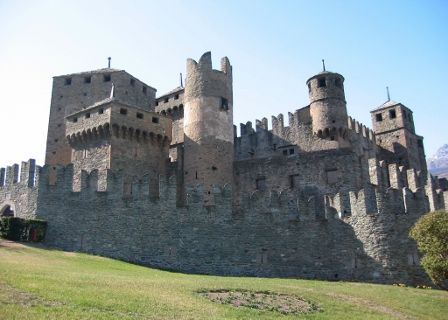
WTI Magazine #85 2016 November 21
Author : italia.it Translation by:
Charming, spectacular Aosta Valley is a region with a lot to offer its visitors. We'll show you a route created ad hoc, that combines nature, sports and culture: A tour of the fantastic castles of Aosta Valley. In addition to being well-known for its mountains, this region is also famous for its charming manors that are seemingly one and the same with the surrounding nature, thus making the landscape even more enchanting. This trip can be experienced by car, on horseback, on a bike and even in pleasant carriages.
Heading up from the bottom of the valley towards Aosta, you first come to the Savoy castle near Gressoney-Saint-Jean, which was the chosen residence of Margaret of Savoy. Built between 1899 and 1904 at the foot of Ranzola hill in the town called Belvedere which dominates the valley up to the Lyskamm glacier, the building has 5 different little cuspidate towers and a luxuriant rock garden home to botanical species that are typical amongst the alpine flora, as well as rare, scented herbs. Make sure to tour the Queen's quarters, which display original furnishings.
Heading down towards motorway A4, a second leg could be Issogne, which is home to a marvellous Gothic Renaissance castle with true treasures of art. The property of the bishops of Aosta, the castle was transformed into a sumptuous residence by Giorgio di Challant, the prior of S. Orso. Make sure to tour it inside, which is skilfully decorated, and the marvellous courtyard with a portico, in the middle of which is an octagonal fountain with a spectacular wrought-iron pomegranate tree.
Not far from Issogne is Verrès, a county town of Roman origin. This is the location of Verrès castle, a recently-restored 14th-century military manor refined by rich decorations on the doors, windows and monumental fireplaces. Construction was completed by Ibleto di Challant in 1390. He was a member of one of the most important noble families in Aosta Valley. This single-block castle is the perfect combination between the majestic and powerful essentiality of a fortress with the elegance of a castle.
Heading back up towards Aosta is the Ussel castle, which was built towards the middle of the 14th century. It belonged both to the Challant and the Savoy families. Used as a prison, this powerful single-block building was donated to the Region by Baron Marcel Bich. Since its skilful restoration by the Region, it has been used as an exhibition area. Built according to typical military architecture, the castle is on a steep rock that dominates the Châtillon plain.
Continuing again in the direction of Aosta, make a quick stop at the majestic Cly castle in Saint-Denis, which rises on a rocky promontory to strategically control the territory below.
Not far from here is the famous Fenis castle, with marvellous crenellated walls and impressive towers. The harmonious structure of this medieval manor (which was transformed into the hunting residence of King Victor Emanuel II') is concentrically organized around the inner courtyard, which evokes a charming and fairy-tale like atmosphere. Don't forget to take a look at the fantastic frescoes inside the chapel.
This trip amongst the castles of Aosta Valley had to include a tour of the marvellous Forte di Bard, an impressive fortress that dates back as early as the year 1000, and that was used as a military structure up until 1830. This fort of the House of Savoy was only reopened after lengthy renovations. Today it is the new cultural centre of the Western Alps along with the homonymous village, and is home to the Museo delle Alpi and many interesting temporary exhibits.
The Royal Sarre castle dominates the entrance to the Valley. It's located in Lalex on a hillock in the Aosta basin. Built in 1710 on the ruins of an even older settlement (12th century), after various owners, the building became the summer residence of the House of Savoy. It is currently the museum for the presence of the House of Savoy in the Aosta Valley. Make sure to visit the Royal Flat, with the Gran Sala del Gioco games room, the Galleria dei Trofei Venatori hunting trophies room and the rooms on the second floor, which related to the history of the Savoy dynasty in the 20th century.
Another leg: The Aymavilles castle, which was erected around the 12th century on a low hill descending towards the Dora River. It was rebuilt between the 14th and 15th centuries and equipped with 4 powerful cylindrical corner towers. In the early 1800's, the old defensive structures were knocked down and the manor was transformed into an elegant residence, as it was given that unique appearance that anticipated the rococò style in the Valley.
Complete this circuit by visiting the Sarriod de la Tour castle in the flat area home to orchards, in the town of Saint-Pierre. It's protected by an extensive wall in a charming position high above the Dora River.
This manor's architecture is complex and it comprises several buildings dating back to different eras. Don't miss the marvellous spiral staircase in the tower (viret), 13th-century frescoes in the chapel and the Sala delle Teste, the official room for receiving guests whose ceiling is upheld by 171 corbels carved in grotesque shapes.



